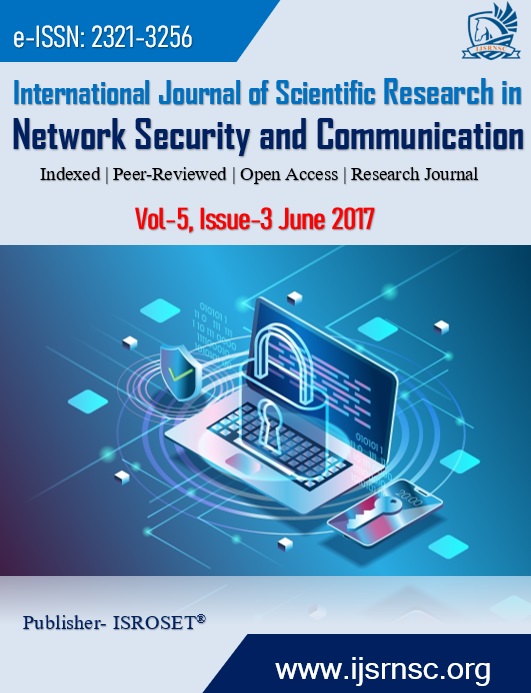Faulty Link Detection in Cluster based Energy Efficient Wireless Sensor Networks
Keywords:
Clustering, Energy efficiency Network lifetime, Fault link, RoutingAbstract
Advancement in electronics and WSNs has enabled the improvement of lower cost and lower power, high transmission. Also in large scale wireless networks, dynamic monitoring of system degradation and detection of bad links proves very difficult. One of the most important challenges in WSN is to design faulty link detection in cluster based energy efficient wireless sensor network to increase the network efficiency, reliability and lifetime. Hot spot in WSNs leads the location having heavy traffic load. Sensor nodes in heavy traffic area drain there energy very quickly, leading in failure link detection of network services and affect WSNs performance including transmitting and receiving of information. Cluster based routing algorithms is utilized to perform energy-efficient routing in WSN and link detection sequentially checks all potential links incurs high transmission. In cluster based routing algorithm, cluster head (CH) represents all nodes in the cluster and data is collected from them. To balance the traffic load and the energy consumption in the network, the size of the cluster should be carefully determined and the rotation of CH among all nodes within the cluster in the network. In this paper, we propose faulty link detection in cluster based energy efficient wireless sensor network algorithm. In WSNs maximum energy is consumed for transmission and reception and energy is non-linear function (exponential) of transmission range. So, in faulty link detection in cluster based energy efficient wireless sensor network election of CH and faulty link detection is based onto the residual energy and optimal CH distance of every node. In addition, Link fails arises in the network if the energy of sensor node falls below threshold value is considered and next shortest routing path is used for transmission for increasing the network lifetime and reliability. Furthermore, the energy consumption of being a CH is equally spread among the cluster members. Performance results show faulty link detection in energy efficient cluster based wireless sensor network scheme reduces the end to end energy consumption, prolong the network lifetime and increase reliability of multi hop network compared to the well-known clustering algorithms LEACH.
References
R. Nathiya, S.G. Santhi, "Energy Efficient Routing with Mobile Collector in Wireless Sensor Networks (WSNs)", International Journal of Computer Sciences and Engineering, Vol.2, Issue.2, pp.36-43, 2014.
Aditya Singh Mandloi, Vinita Choudhary, "An Efficient Clustering Technique for Deterministically Deployed Wireless Sensor Networks", International Journal of Scientific Research in Network Security and Communication, Vol.1, Issue.1, pp.6-10, 2013.
S. Sharma, D. Kumar and K. Kishore, "Wireless Sensor Networks- A Review on Topologies and Node Architecture", International Journal of Computer Sciences and Engineering, Vol.1, Issue.2, pp.19-25, 2013.
D. Son, B. Krishnamachari, J. Heidemann, “Experimental analysis of concurrent packet transmissions in low-power wireless networks”, In Proceedings of ACM SenSys, USA, pp.1-9, 2005.
M. Steinder, A.S. Sethi, “Probabilistic fault localization in communication systems using belief networks”, IEEE/ACM Transactions on Networking, Vol.12, Issue.5, pp.809-822, 2004.
S. Agrawal, K.D. Kulat, M.B. Daigavane, "Evaluation of Routing Algorithm for Ad-hoc and Wireless Sensor Network Protocol", International Journal of Computer Sciences and Engineering, Vol.1, Issue.2, pp.11-18, 2013.
W. R. Heinzelman, A.C.H. Balakrishnan, “Energy efficient communication protocol for wireless micro sensor networks”, HICSS, vol. 2, pp.4 -7, 2000.
Aditya Singh Mandloi, Vinita Choudhary, "An Efficient Clustering Technique for Deterministically Deployed Wireless Sensor Networks", International Journal of Scientific Research in Network Security and Communication, Vol.1, Issue.1, pp.6-10, 2013.
H. Chan, A. Perrig, “ACE: An emergent algorithm for highly uniform cluster formation”, First European Workshop, Germany, pp. 154 -71, Jan 2004.
Sanjay S Bhadoria and Hitesh Gupta , "A Wearable Personal Healthcare and Emergency Information Based On Mobile Application", International Journal of Scientific Research in Computer Science and Engineering, Vol.1, Issue.4, pp.24-30, 2013.
C. Intanagonwiwat, R. Govindan, D. Estrin, J. Heidemann, F. Silva, “Directed diffusion for wireless sensor networking”, IEEE/ACM Transactions on Networking, vol. 11, no. 1, pp.2-16, 2003.
O. Younis, S. Fahmy, “Heed: a hybrid, energy-efficient, distributed clustering approach for ad hoc sensor networks”, IEEE Transactions on Mobile Computing, vol. 3, no. 4, pp.366-379, 2004.
Chengfa Li, Mao Ye, Guihai Chen, Jie Wu, “An energy-efficient unequal clustering mechanism for wireless sensor networks”, IEEE International Conference on in Mobile Adhoc and Sensor Systems Conference, china, pp. 8604-09, 2005.
H. Chan, A. Perrig, “Ace: an emergent algorithm for highly uniform custer formation”, Lecture Notes in Computer Science, germeny, pp.67-71, 2004.
Sangho Yi, Junyoung Heo, Yookun Cho, Jiman Hong, “Peach: Power-efficient and adaptive clustering hierarchy protocol for wireless sensor networks”, Computer Communications, vol. 30, Issue.14, pp. 2842 - 2852, 2007.
S.S. Ahuja, S. Ramasubramanian, M.M. Krunz, “Single-link failure detection in all-optical networks using monitoring cycles and paths”, IEEE/ACM Transactions on Networking, Vol.17, Issue.4, pp.1080-1093, 2009.
U. Korupolu, S. Kartik, GK. Chakravarthi, "An Efficient Approach for Secure Data Aggregation Method in Wireless Sensor Networks with the impact of Collusion Attacks", International Journal of Scientific Research in Computer Science and Engineering, Vol.4, Issue.3, pp.26-29, 2016.
P.M Shankar, “Introduction to Wireless Systems”, John Wiley and Sons, Singapure, pp.1-18, 2001.
Aristidis likas, Nikas vlassis, Jacab J Verbeek, “The global k-means clustering algorithm”, Pattern recognition, Vol.36, Issue.2, pp.451-61, 2003.
Downloads
Published
How to Cite
Issue
Section
License

This work is licensed under a Creative Commons Attribution 4.0 International License.
Authors contributing to this journal agree to publish their articles under the Creative Commons Attribution 4.0 International License, allowing third parties to share their work (copy, distribute, transmit) and to adapt it, under the condition that the authors are given credit and that in the event of reuse or distribution, the terms of this license are made clear.









